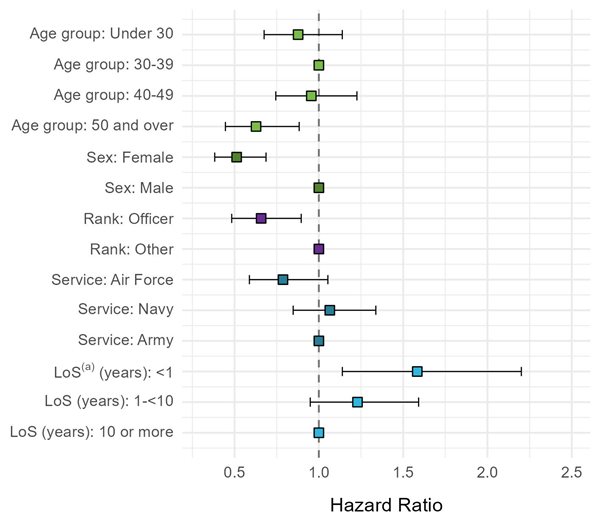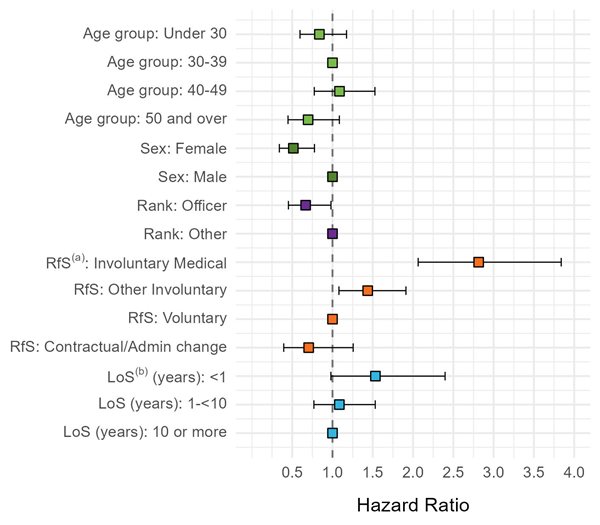Modelling suicide rates over time
On this page:
Summary of key findings
Cox proportional hazards modelling was carried out to see which service-related factors were most strongly associated with suicide death in the ex-serving ADF population over time when all other available factors are accounted for.
Results show that the following service-related characteristics were associated with significantly higher or lower instantaneous rates (meaning the rates at any instant) of suicide among the ex-serving population, holding all other available factors constant:
- Those aged 50 and over have a hazard ratio of 0.6 compared to those who are 30-39 years old. This implies a lower rate of suicide for those ages 50 and over: that is 0.6 times the suicide rate for those aged 30-39 years. For more information on how to interpret hazard ratios see Box 3.
- Those who are female have a lower (0.5 times) rate of suicide compared to those who are male.
- Those who are commissioned officers at the time of separation have a lower (0.7 times) rate of suicide compared to those who are of other ranks other than commissioned officers.
- Those who have served for less than 1 year have a higher (1.6 times) rate of suicide compared to those who have served for 10 or more years.
- Those who have left for involuntary medical reasons have a higher (2.8 times) rate of suicide compared to those who left voluntarily.
- Service (Navy, Army, Air Force) was not found to be a statistically significant predictor of suicide once all other factors were controlled for.
These results indicate that the rate of suicide is lower in those who are over 50 years of age, female, commissioned officers, have served for 10 or more years, and left voluntarily.
While these results can identify groups of people who have a higher rate of suicide, they cannot indicate if any specific characteristic is the reason for a suicide death. There is limited data on the sequencing of factors/exposures that can contribute to suicide death. Qualitative analysis methods may provide insight into the circumstances leading up to suicide death.
Introduction to modelling suicide rates
The 2021 suicide monitoring report, Serving and ex-serving Australian Defence Force members who have served since 1985: suicide monitoring 2001 to 2019, and the analyses of the previous chapters, used univariate analysis to report the rates of suicide. This approach is somewhat limited in that the different variables must be looked at in isolation.
In this chapter Cox proportional hazards modelling is used to identify and compare interactions between variables. This multi-factor analysis compliments the trends and conclusions observed above or in previous reports, providing further insight into the factors associated with suicide while independently confirming previous analyses.
Cox proportional hazards survival modelling for ex-serving members
Cox proportional hazard modelling was used to perform survival modelling analyses where the occurrence of suicide was monitored once an individual has separated from the ADF. Since separation from the ADF marks the entry of an individual into this model it does not account for permanent or reserve members, only ex-serving. See the Technical notes for a deeper discussion of this technique.
Two models are presented, the first for ex-serving members who separated on or after 01 January 1997, while analysing the variables: age group, sex, rank, service, and length of service.
The second model contains all ex-serving members who separated on or after 01 January 2003 and will assess reason for separation alongside: age group, sex, rank, and length of service. This model is interested specifically in reason for separation, so the monitoring period was restricted the post-2003 cohort (which has accurate separation data).
Note that senior and junior other ranks were merged into an “other ranks” category and length of service groups were aggregated into <1, 1-10, and 10 or more groups. This was done to maximise the population numbers within these subgroups, for more robust statistical analyses.
Also note that the distinction between permanent ex-serving and reserve ex-serving did not satisfy the proportional hazards assumption (see Box 3), as the suicide rates for these cohorts get closer together with time. Therefore, this could not be included.
Box 3: Interpretation of hazards ratios in survival modelling
The modelling results are expressed as hazard ratios (HR), which in this context represents the multiplicative difference in instantaneous rate of suicide between two groups within a variable while holding all other analysed variables constant. Groups within a variable are compared to a reference group which was nominated to be the most populous subgroup for each variable. Hazard ratios are assumed to be constant over time (this is the proportional hazards assumption) and variables for which this is not so are excluded.
To elaborate, for two groups within a variable, Group A and Group B, where Group A is the reference group, and Group B is the study group, if the HR = 2, this can be interpreted as: individuals in Group B have double the rate of death by suicide at every instant compared to individuals in Group A at any given time over the course of the model, holding all other analysed covariates constant. HRs are multiplicative across the model variables.
At any point during the monitoring period:
- A group with HR > 1 suggests an increased rate of suicide relative to the reference group while holding all other variables constant.
- A group with HR < 1 suggests a decreased rate of suicide relative to the reference group while holding all other variables constant.
- A group with HR = 1 suggests no difference rate of suicide relative to the reference group while holding all other variables constant.
The 95% confidence intervals (CI) for each HR are provided where HRs are considered significant difference to the reference group if the 95% CI does not contain the value 1.
Suicide monitoring by survival modelling: 1997–2020
This analysis contains all ex-serving members of the ADF who separated on or after 01 January 1997 and models the rate of suicide over time across the variables:
- age group
- sex
- rank
- service
- length of service.
Time since separation is excluded since it represents the time variable of the model itself (measuring the time between separation from the ADF and death by suicide). As such it cannot be included for analysis.
The reference groups for comparison were selected to be those that were most populous within each variable over the model period. These were 30-39 years of age, male, ranks other than officer, Army, and 10 or more years length of service.
While holding all other analysed variables constant, the instantaneous rate of suicide in the ex-serving population at any point between 1997-2020 was:
- 0.6 times in those aged 50 and over compared to those who are 30-39 years old.
- 0.5 times in those who are female compared to those who are male.
- 0.7 times in those who are commissioned officers compared to those who are of ranks other than commissioned officers.
- 1.6 times in those who served for less than 1 year compared to those who have served for 10 or more years.
Service was not found to be a statistically significant predictor of suicide once all other factors were controlled for. The model outputs are given in full in Table 11, and Figure 18 below.
| Variable | Reference | Study group | Hazard ratio | Lower 95% CI | Upper 95% CI | Significant difference to reference |
|---|---|---|---|---|---|---|
| Age group (years) | 30-39 | Under 30 | 0.9 | 0.7 | 1.1 | No |
| 40-49 | 1.0 | 0.7 | 1.2 | No | ||
| 50 and over | 0.6 | 0.4 | 0.9 | Yes, Lower | ||
| Sex | Male | Female | 0.5 | 0.4 | 0.7 | Yes, Lower |
| Rank | Other | Officer | 0.7 | 0.5 | 0.9 | Yes, Lower |
| Service | Army | Air Force | 0.8 | 0.6 | 1.1 | No |
| Navy | 1.1 | 0.8 | 1.3 | No | ||
| Length of service (years) | 10 or more | <1 | 1.6 | 1.1 | 2.2 | Yes, Higher |
| 1-<10 | 1.2 | 0.9 | 1.6 | No |
Source: AIHW analysis of linked Defence historical personnel data–PMKeyS–NDI data 1985–2020.
Figure 18: Hazard ratios for suicides over time of the ex-serving population: 1997–2020, by survival modelling

Note:
- LoS is Length of service
Source: AIHW analysis of linked Defence historical personnel data–PMKeyS–NDI data 1985–2020.
Suicide monitoring by survival modelling with reason for separation: 2003–2020
This analysis contains all ex-serving members of the ADF who separated on or after 01 January 2003, and models rate of suicide over time across the variables:
- separation reason
- age
- sex
- rank
- length of service.
The reference groups for comparison were again selected to be those that were most populous over the model period within each variable. These were 30-39 years of age, male, ranks other than officer, voluntary separation, and 10 or more years length of service. Since this model contains fewer people than the 1997-2020 one, results for variables other than reason for separation should not be taken as more meaningful here. For example, there is insufficient evidence to conclude that the introduction of reason for separation as a variable renders age no longer significant.
While holding all other analysed variables constant, the rate of suicide for people who separated from the ADF for involuntary medical reasons at any point between 2003-2020 is 2.8 times compared to those separated voluntarily.
These results are given in detail below (see Table 12 and Figure 19).
| Variable | Reference | Study group | Hazard ratio | Lower 95% CI | Upper 95% CI | Significant difference to reference |
|---|---|---|---|---|---|---|
| Age group (years) | 30-39 | Under 30 | 0.8 | 0.6 | 1.2 | No |
| 40-49 | 1.1 | 0.8 | 1.5 | No | ||
| 50 and over | 0.7 | 0.4 | 1.1 | No | ||
| Sex | Male | Female | 0.5 | 0.3 | 0.8 | Yes, Lower |
| Rank | Other | Officer | 0.7 | 0.5 | 1.0 | Yes, Lower |
| Reason for separation | Voluntary | Involuntary Medical | <2.8 | 2.1 | 3.8 | Yes, Higher |
| Involuntary Other | 1.4 | 1.1 | 1.9 | Yes, Higher | ||
| Contractual or administrative change | 0.7 | 0.4 | 1.3 | No | ||
| Length of service (years) | 10 or more | <1 | 1.5 | 1.0 | 2.4 | No |
| 1-<10 | 1.1 | 0.8 | 1.6 | No |
Source:AIHW analysis of linked Defence historical personnel data–PMKeyS–NDI data 1985–2020.
Figure 19: Hazard ratios for suicides over time of the ex-serving population: 2003–2020, by survival modelling

Notes:
- RfS is Reason for separation
- LoS is Length of service
Source: AIHW analysis of linked Defence historical personnel data–PMKeyS–NDI data 1985–2020.
This result confirms that involuntary medical separation is a significant risk factor for suicide even when accounting for the other model variables.
Data underlying this graph are available in Supplementary table S8.1-S8.6. See Data for a link to the tables.
Please note, data for more recent years are subject to change; see the Technical notes for further detail.
If you need help or support, please contact:
- Open Arms - Veterans and Families Counselling 1800 011 046
- Open Arms Suicide Intervention page
- Defence All-hours Support Line (ASL) 1800 628 036
- Defence Member and Family Helpline 1800 624 608
- Defence Chaplaincy Support 1300 333 362
- ADF Mental Health Services
- Lifeline 13 11 14
- Suicide Call Back Service 1300 659 467
- Beyond Blue Support Service 1300 22 4636
For information on support provided by DVA, see:


